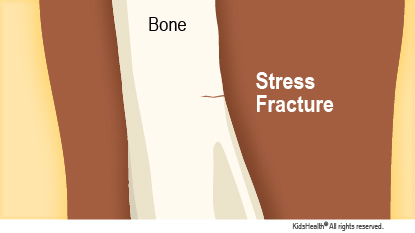Stress Fractures
What Is a Stress Fracture?
A stress is a tiny crack in a bone.
What Causes Stress Fractures?
Stress fractures usually happen from repeating the same movement over and over (such as when someone trains for a sport). They also can happen from everyday activities in people whose bones are weak due to poor nutrition or a medical condition.
What Are the Signs & Symptoms of a Stress Fracture?
If you have a stress fracture, you might notice:
- pain when exercising that may or may not go away after rest
- tenderness
- mild swelling and redness
The lower leg and the foot are the most common areas to get a stress fracture. But they also can happen in other areas, such as the arm, spine, or ribs.

How Are Stress Fractures Diagnosed?
To diagnose a stress fracture, your health care provider will first ask about your general health and activities (such as sports). Then he or she will do an exam to check for tenderness, swelling, or redness. X-rays are usually done.
Some stress fractures don't show up on an X-ray until a few weeks after the bone starts hurting. Sometimes an MRI scan or a is needed.
How Are Stress Fractures Treated?
The most important parts of recovering from a stress fracture are:
- resting the injured area
- taking a break from sports
Sometimes a stress fracture will need a cast, splint, brace, or boot. Rarely, surgery is needed.
If you have pain from a stress fracture, you can:
- Place a cold compress or ice wrapped in a towel on the area for about 15 minutes three times a day.
- Take pain medicine as recommended by the health care provider.
Nutritional or psychological counseling can help if a stress fracture happens because of poor nutrition or an eating disorder.
What Can I Do While Healing From a Stress Fracture?
Ask the health care provider if you can exercise a part of the body that does not have the stress fracture. For example, if you have a stress fracture in your foot, you might be able to do arm and shoulder exercises. This can help you stay active during healing.
After a few weeks, your health care provider may give you the OK to slowly start to increase activity. The provider may recommend physical therapy to help you safely return to sports.
Can Stress Fractures Be Prevented?
To help prevent stress fractures:
- Eat a healthy diet that includes plenty of calcium and vitamin D.
- Know that the risks of smoking include slowed healing of broken bones.
If you're very active or play sports:
- Always warm up before practices and meets.
- Start any new activity or exercise slowly.
- Slowly increase how long and how hard you train.
- Stop any activity or exercise if pain or swelling starts.
- Use the right sports equipment, especially supportive shoes in good condition.
What Else Should I Know?
If found early and treated correctly, most stress fractures heal well. But going back to activities too soon can make a tiny stress fracture larger and harder to heal.
Follow the doctor's directions so that you can get back to activities and sports as soon as possible.
- Dealing With Sports Injuries
- Calcium
- Sports and Exercise Safety
- Broken Bones
- Sports Medicine (Topic Center)
- Splints
- Greenstick Fractures
- Comminuted Fractures
- Compulsive Exercise
- Eating Disorders
- Overuse Injuries
- Knee Injuries
- How Broken Bones Heal
- Casts
- Safety Tips: Running
- Broken Collarbone (Clavicle Fracture)
- Bones, Muscles, and Joints
- Strains and Sprains

© 1995- The Nemours Foundation. KidsHealth® is a registered trademark of The Nemours Foundation. All rights reserved.
Images sourced by The Nemours Foundation and Getty Images.

